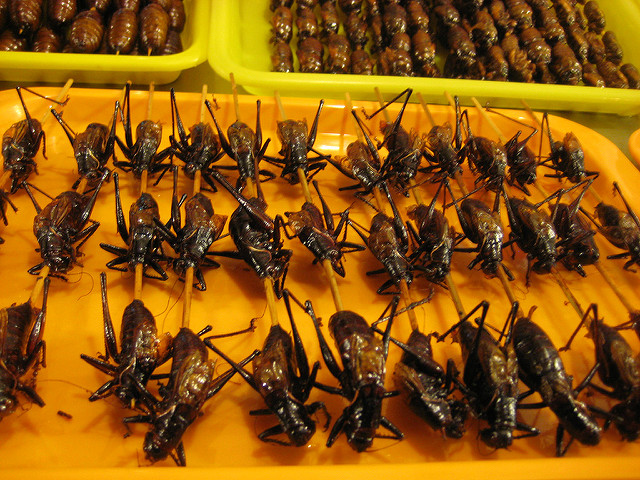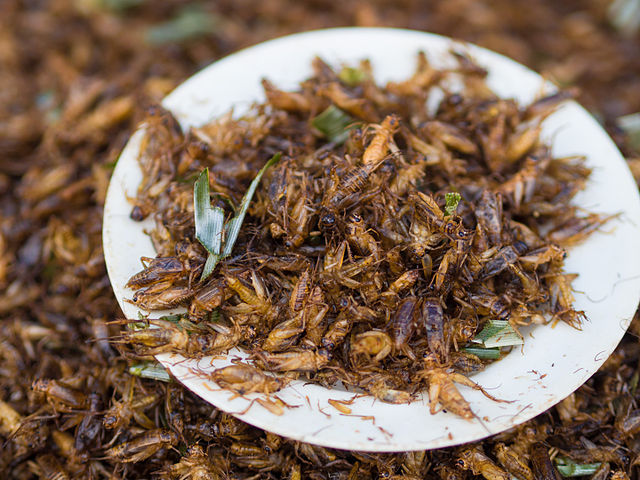Cricket farming Q&A with Newtri Foods (Part 1)
The founders of Newtri Foods talk to science engagement officer, Robyn Hopcroft, about cricket farming in Part 1 of a Q&A about their edible insect business.
Edible insects have been touted as the next big thing in food. Even the United Nations has recognised edible insects as a “promising alternative for the conventional production of meat…”

So at MERL we’ve been thinking about the future of food and investigating edible insects as one possible means of addressing the growing need for sustainable sources of protein. Last month I witnessed many people taking to edible insects with great enthusiasm at the University of Reading Big Band Lunch. This week, we paid a visit to the Highdown School Science Fair, where game students were lining up try mealworms, cricket flour brownies and giant waterbugs.
While watching people chomp on creepy crawlies is quite entertaining, it also made me wonder about the other side of things. I’ve seen people consume plenty of insects, but how are they produced? What’s the deal with edible insect farming? Thankfully I managed to track down a couple of friendly cricket farmers based in Northampton, who were happy to answer a bunch of questions posed by the curious staff at MERL.
This is the first part of a Q&A with Matt Grant and Matt Hardy – Co-founders of Newtri Foods. Newtri Foods aims to be one of the first companies in the UK dedicated to the farming of crickets and the creation of cricket-based products (flour, protein bars and whole crickets) exclusively for human consumption.
How, when and why did you get into edible insect farming? Where did the idea come from?
We have both been lucky enough to have travelled extensively. Matt H explored South East Asia for a year whilst Matt G lived and worked in South America for a year. Through these travels we both had the opportunity to try various meals and dishes that incorporated insects. They were all extremely tasty and after a bit of research we soon realised that they were also extremely healthy. This got us thinking as to why very few people in Europe consume insects and if the option was available in various forms whether people would give it a try. Currently many UK companies producing cricket-based products are importing from places like Thailand and Canada. The fuel used to transport them to the UK offsets the environmental benefits of consuming insects so we want to assist this market by providing these companies with locally sourced crickets, reducing their carbon footprint and the impact on the environment as a whole.
Are you regular insect eaters, yourselves?
We have tried a range of different insect-based products and dishes abroad and often include cricket flour in our daily lunches and dinners. Healthy cricket flour brownies are one of our favourite snacks!
Why crickets and not some other kind of insect?
We are both enthusiastic about maintaining a fit and healthy lifestyle and the high protein content in crickets was something that attracted us to farming them. Crickets are also one of the insects that are most accepted by the wider population to eat, and they have a mild taste so it seems like a great place to start and get people accustomed to eating insects before other insect types enter the market.
What type/s of cricket do you use? Where do they originate from? Are all types of crickets edible?
We currently farm the Acheta Domesticus species, and the original batches were sourced from the USA where cricket-consumption is a lot more established. All the breeds we have researched so far can be consumed by humans.

What are the steps to raising crickets?
We raise our crickets in a sterile environment with a minimum temperature of 25-28 degrees Celsius. The warmer the temperature the more active the crickets are, which promotes their breeding activities as well. We have a separate area for incubating the eggs and managing the young crickets before reaching adult size.
Do they ever escape?
Thankfully none have escaped our units so far, although it can be difficult with the babies! We have toyed with the idea of keeping a resident lizard in the warehouse to catch escapees before they get outside the unit!
What do you feed them?
Our crickets are fed on a gluten-free organic feed; this is supplemented by fresh organic vegetables from our allotment.
How are crickets harvested? Is it humane? Is there ethical guidance on farming insects for food?
Yes, there is ethical guidance on farming insects which is widely available and discussed online on respected forums and organisations’ websites. Crickets are cold-blooded and therefore the most humane way to harvest them is to reduce their body temperature through freezing which humanely and rapidly slows down their metabolism.
What are the steps to making cricket flour?
Our crickets go through multiple different stages before being made into cricket flour from freezing to drying. Unfortunately this is a process that we cannot reveal too much about for the moment!
Do you use the whole insect to make flour?
No, the cricket’s wings and legs are sifted out throughout the process. This isn’t to say that none slip through, however they are just as edible as the rest of the cricket!

Around how many crickets does it take to make a bag of flour?
Quite a few and it depends on the size. We’ve found that it roughly takes around 1000 crickets to produce 100-120 grams of flour.
How long does it take to get from cricket egg to cricket flour?
The cycle is usually six to seven weeks from hatched baby to harvesting time.
How easy is cricket flour to use in baking? Is it just for use as a replacement for wheat flour?
Cricket flour is not a substitute for wheat flour. Although flour is in its name it is a different ingredient and can be used in protein bars, drinks, smoothies, and baked products to add a significant protein boost and health-kick to whatever you are making.
[Check out Part 2 of our cricket farming Q&A with Newtri Foods]
